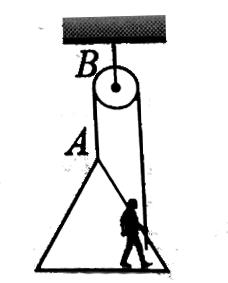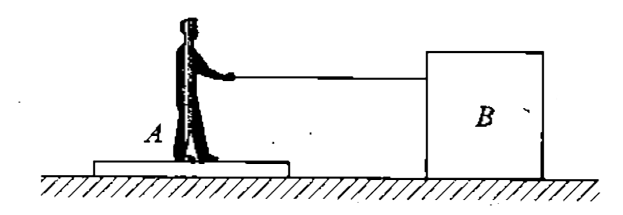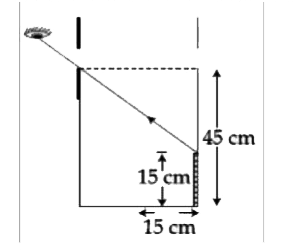
To paint the side of a building, painter normally hoists himself up by pulling on the rope A as in figure. The painter and plateform together weigh 200 N. The rope B can withstand 300 N. Then
The maximum acceleration that painter can have upwards is .
To hoist himself up, rope B must withstand minimum 400 N force.
Rope A will have a tension of 100 N when the painter is at rest.
The painter must exert a force of 200 N on the rope A to go downwards slowly.
The correct Answer is:A, C


Maximum force, the rope B can withstand is 300 N, so the maximum tension which can be produce in rope A should be
(i) For maximum acceleration:
(ii) Now to hoist up (say with uniform velocity), minimum tension in A should be 100 N (or painter should apply force of 100 N on rope A), then minimum tension in B should be 200N. So B should withstand minimum tensin of 200 N. Same is the case to move down slowly.
(iii) When the painter is at rest the tension in A should be 100 N to balance the weight of paiter and platform. So painter will exert 100 N on rope A.
Similar Questions
Figure represents a painter in a crate which hangs alongside a building. When the painter of mass 100kg pulls the rope, the force exerted by him on the floor of the crate is 450N. If the crate weighs 25 kg. find the acceleration (in ms−2) of the painter.

View SolutionFigure shows a boy on a horizontal platform A on a smooth horizontal surface, holding a rope attached to a box B. Boy pulls the rope with a constant force of 50 N. The combined mass of platform A and boy is 250kg and that' of box B is 500kg. The velocity of A relative to the box B 5 s after the boy on A begins to pull ,the rope,will be:
 (A)1ms(B)2ms(C)0.5ms(D)1.5ms
(A)1ms(B)2ms(C)0.5ms(D)1.5ms
View Solution
Knowledge Check
A painter will paint n walls with the same size and shape in a building using a specific brand of paint. The painter’s fee can be calculated by the expression nKAh, where n is the number of walls, K is a constant with units of dollars per square foot, A is the length of each wall in feet, and h is the height of each wall in feet. If the customer asks the painter to use a more expensive brand of paint, which of the factors in the expression would change?
AhBlCKDn
Two painters are working from a wooden hoard 5m long suspended from the top of a building by two ropes attached to the ends of the plank. Either rope can withstand a maximum tension of 1040N. Painter A of mass 80kg is working at a distance of 1m from one end. Painter B of mass 60kg is working at a distance of x in from the centre of mass of the board on the other side. Take mass of the board as 20kg and g=10ms−2. The range of x so that both the painters can work safely is
View SolutionA painter of mass M stands on a platfrom of mass m and pulls himself up by two ropes which hang over pulley as shown in fig. He pulls each rope with force F and moves upward with a uniform acceleration a. find a, neglecting the fact that no one could do this for long time.

View SolutionA can of paint with a mass of 6 kg hangs from a rope. If the can is to be pulled up to a rooftop with an acceleration of 1m/s, what must be the tension in the rope ?
View SolutionA 30 kg crate is moved along a horizontal floor by a warehouse worker who's pulling on it with a rope that makes a 60∘ angle with the horizontal. The tension in the rope is 200 N and the crate slides a distance of 10 m. how much work is done on the crate by the worker?
View SolutionFind the least horizontal force P to start motion of any part of the system of the three blocks resting upon one another as shown in figure The weights of blocks are A=300N,B=100N and C=200N .Between A and B , the coefficient of friction is 0.3 between B and C is 0.2 and between C and the ground is 0.1

View SolutionAn observer can see through a small hole on the side of a jar (radius 15 cm) at a point at height of 15 cm from the bottom (see figure). The hole is at a height of 45 cm. When the jar is filled with a liquid up to a height of 30 cm the same observer can see the edge at the bottom of the jar. If the refractive index of the liquid is N/100, where N is an integer, the value of N is ___________.

View SolutionA can of paint with a mass of 6 kg hangs from a rope. If the can is to be pulled up to a rooftop with an acceleration of 1m/s2, what must be the tension in the rope ?
View Solution
